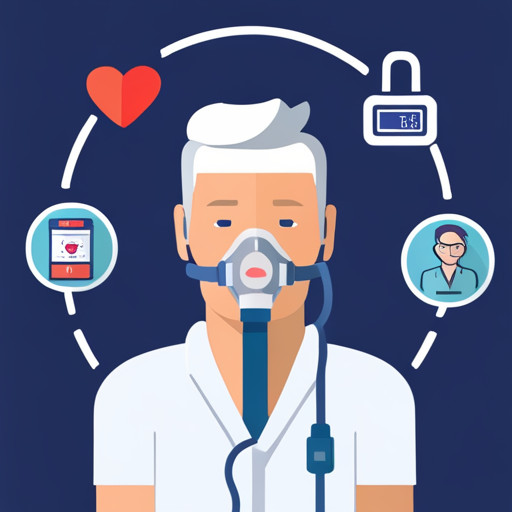Philips CPAP Machine Lawsuits
Update October 10th 2023 - I have seen some complaints on social media about the law firm marketing tactics around CPAP, showing masks worn incorrectly or other stock images that don't seem to understand those suffering from sleep apnea and the cruel twist that came from wearing a medically diagnosed device every night only to discover you are were breathing in toxic contaminants.

Despite over 350,000 CPAP machines being subject to the recall, we only see around 747 total cases filed and only 698 pending. Perhaps more will be filed in the coming months.
The American Medical Association estimates that nearly 30 million Americans suffer from sleep apnea, but only a small fraction — about twenty percent — are actually diagnosed with this condition. Those who are diagnosed with sleep apnea often find relief using a CPAP machine to assist them in breathing more freely at night.
If you have been diagnosed with sleep apnea, you too may use a continuous positive airway pressure (CPAP) machine. However, one popular manufacturer of CPAP machines is facing lawsuits from consumers who allege that toxic materials in the affected CPAP machines and ventilators can lead to cancer and other health complications.
An Overview of Sleep Apnea and Its Treatment
Sleep apnea is a general term that describes three main conditions:
- Obstructive sleep apnea (OSA): the throat muscles soften during sleep and obstruct the flow of air into the lungs
- Central sleep apnea (CSA): the brain doesn’t transmit appropriate signals to the muscles involved in proper breathing
- Complex sleep apnea: a person diagnosed and receiving treatment for OSA develops CSA
In all forms of sleep apnea, your breathing is interrupted while you sleep. You may find that your breathing stops and starts repeatedly throughout the night, and you may wake up tired no matter how long you have slept. Other symptoms of sleep apnea include:
- Loud snoring during sleep
- Hypersomnia, or daytime tiredness and sleepiness
- Trouble focusing or paying attention while you are awake
- Dry mouth or headache upon waking up
- Cessation of your breathing during sleep, reported to you by someone else
In some cases, unresolved sleep apnea can lead to other, more serious health complications such as heart disease.
Treatment for OSA, the most common form of sleep apnea, generally involves the use of a CPAP machine to help keep your airways open. You may also receive an oral device that treats sleep apnea by keeping your throat open during sleep. Surgery may be necessary if other treatment options fail or if your sleep apnea is severe.
Philips CPAP Machine: Design, Defects, and Dangers
Philips Respironics is one of the world’s largest manufacturers of sleep apnea machines. One popular model is the Philips DreamStation CPAP. This device delivers air pressure into the patient’s airways by means of a flexible tube running from the machine to a fitted facemask worn by the patient.
During use, the air pressure generated by the machine and delivered to the patient acts to keep the patient’s throat open while the patient sleeps. The patient receives an adequate supply of air throughout the night, breathing is not interrupted, and the patient receives a restful night of sleep.
Like other CPAP machines, the DreamStation makes noise as it generates air pressure. This noise can interfere with the patient’s sleep. To address this issue, the designers of the DreamStation used a polyester-based polyurethane (PE-PUR) foam to help dampen the sound made by the machine.
Damaged Foam Presents Health Risks to Consumers
It has since come to light that the foam used by Philips DreamStation CPAP can degrade over time. Using ozone-cleaning devices to clean the CPAP can also cause degradation in the foam. Particles from the degraded foam can make their way into the tubing and mask, leading patients to inhale these particles.
Foam particles pose a significant health risk to patients if they are inhaled or ingested. They can cause a variety of cancers, including lung, kidney, bladder, and stomach cancer. The particles can also cause additional health complications for patients, including:
Other Cancers
In addition to the aforementioned cancers, PE-PUR foam could lead to brain cancer, breast cancer, liver cancer, rectal cancer, nasal cancer, lymphatic cancer, and prostate cancer.
Respiratory Disorders
Some of the respiratory difficulties associated with inhalation or ingestion of the foam used in Philips DreamStation CPAP include the following:
- Severe inflammation of the nose and throat
- Acute respiratory distress syndrome
- Respiratory failure
- Reactive airway disease
- Lung damage and lung disease
Some of these conditions can be life-threatening and require medical intervention to correct. If you have been using a Philips CPAP device, especially a Philips DreamStation, and you notice any indications of these conditions, visit your doctor as soon as you can.
Heart Trouble and Other Complications
Headaches, chest pressure, heart attack, and heart failure are all additional side effects and complications believed to be associated with exposure to the toxins found in PE-PUR foam. These conditions can be life-threatening as well, so do not delay in seeking evaluation and treatment if you suspect any heart-related side effects.
Philips Recalls DreamStation CPAPs over Toxic Foam
In June 2021, Philips recalled millions of its CPAP machines, bilevel positive airway pressure (BiPAP) machines, and ventilators over the dangers associated with degraded PE-PUR foam.
An inspection completed by the Food and Drug Administration (FDA) suggested that Philips was aware as early as 2015 that the PE-PUR foam it was using in its devices could degrade and pose health hazards to consumers.
Beginning in September 2021, Philips indicated it intended to address the issues with its CPAP and other machines by repairing or replacing them over the course of the next year. In November of that same year, though, an FDA report concluded that the foam Philips was using to replace the PE-PUR foam was also potentially hazardous to patients’ health.
Additional Recalls Announced in 2022
The problems impacting Philips and its medical devices did not stop with 2021’s recall. In September 2021, Philips issued a warning to consumers about magnets found in its CPAP masks. According to Philips, these magnets could cause serious or potentially deadly interference with patients’ pacemakers, stents, and other medical devices.
The same month, Philips also recalled 1,660 of its BiPAP machines because of defective plastic parts. According to the recall notice, the plastic parts at issue could interfere with the machine working properly or give off chemical fumes that were toxic to humans.
Philips initially addressed this new danger in its products by adding warnings to the affected devices’ packaging. But in October 2022, the FDA informed the public that a Class I recall of the affected masks was being pursued due to their risk of causing serious injury or death.
Lawsuits Against Philips: What You Need to Know
There are hundreds of lawsuits pending against Philips, alleging that the company knowingly permitted a product it knew to be dangerous to be sold to consumers.
When manufacturers learn that a product of theirs is dangerous, they must take reasonable steps to make the product safe or warn the public of the dangers its product poses to them.
Rather than taking these steps, the lawsuits generally allege, Philips learned that its CPAP and other machines might pose a risk to consumers and then sat on the information for years.
The lawsuits are brought by plaintiffs seeking financial damages for expenses they incurred as a result of the company’s actions. These expenses include medical care and treatment, loss of enjoyment of life, lost wages, and expenses associated with obtaining alternative treatment for sleep apnea.
Symptoms Suggesting Injury from a Philips CPAP Device
It may not be apparent when you have been exposed to toxic degraded foam in your CPAP device. This is because some of the symptoms of exposure mimic a variety of other conditions. Additionally, symptoms may not persist but may resolve on their own with or without medical attention.
Nonetheless, if you use a Philips DreamStation CPAP or other Philips device and notice any of the following symptoms, you should talk to your doctor:
- Cough, asthma, or chest pressure
- Irritation in your nose and upper airway
- Dizziness or headaches
- Nausea or vomiting
- Unexplained damage to organs like your liver and kidneys
Speak with your medical provider even if these symptoms appear to go away or do not initially appear to be severe.
Potential Legal Rights if You Used a Philips DreamStation or Other Device
If you used a DreamStation or other Philips CPAP, BiPAP, or ventilator, and you developed health complications thereafter, you may have the right to bring suit against Philips. You could file and pursue your claim individually, or you may qualify to combine your claim with the claims of other plaintiffs in a class action lawsuit.
To prevail in your claim, the evidence will need to show the following:
Your CPAP Machine is Defective and Dangerous
You should not throw out your Philips CPAP device, even if you are now using some other tool or device to treat your sleep apnea. Your lawyer will want to examine your Philips device carefully to identify the defects that are present in it and whether it was subject to any one of the manufacturer’s or FDA’s recalls.
The nature of the defect, if present, matters greatly. If the defect present in your Philips CPAP is one that was identified in the recalls, there is a good chance that your claim can proceed. If the defect is one that was not previously identified, then your claim may proceed if evidence shows Philips knew or should have known about it but did nothing to correct it.
The Defect in Your CPAP Led to Your Health Condition or Injury
Next, your claim will need to establish a causal link between your defective Philips CPAP and any health complication or condition it caused. You can assist your attorney in making this connection by:
- Knowing when you began using your Philip CPAP machine and when you began experiencing symptoms of serious health conditions
- Having a copy of any diagnosis made by your doctor after using your CPAP
- Gathering the medical records that document your doctor’s treatment of you
- Continuing with any care that your doctor recommends for your new conditions
- Keeping copies of bills, invoices, receipts, and notes about all absences from work caused by your health conditions
Keep in mind that you do not have to be 100 percent certain that your Philips CPAP device caused the symptoms you are experiencing before you speak with an attorney or file a lawsuit.
Have Your Claim Evaluated for Free
If you are still uncertain whether you might have a claim for damages against Philips, you can complete the form on the side of this page. This will give you a free evaluation of your case and can help you decide whether to contact an attorney for additional information and guidance.
Settlements Versus Trial Awards in CPAP Lawsuits
Because CPAP lawsuits against Philips for using toxic PE-PUC foam are in their early stages, it is impossible to say with any certainty whether Philips intends to litigate plaintiffs’ claims or whether it will seek settlements.
Generally, settlements save companies like Philips from expensive and time-consuming litigation. Additionally, the amount of compensation paid by the company is oftentimes less than what a jury would award after a trial.
Whether your case is resolved through a settlement or a jury verdict, you can expect to receive some compensation for your losses if you prevail. Specifically, you may receive compensation for the following losses and expenses:
- Medical tests and treatment to diagnose and care for your qualifying condition
- Time you missed from work to attend doctor’s appointments and hospitalizations
- Lost future earnings you cannot earn because of permanent or partial disability
- Loss of enjoyment of life and decreased life expectancy
- Anxiety, depression, and other mental trauma you experienced
It is still too early to say whether punitive damages may be awarded against Philips. Punitive damages are meant to punish a defendant for calloused, shocking, or egregious behavior.
Courts will consider when Philips knew about the dangerous nature of its PE-PUR foam, how long it took Philips to take action, and what actions they did take to address the issue.
Retain Qualified Legal Counsel to Stay Informed
As CPAP lawsuits against Philips progress, expect to gain additional information and insight from your attorney about how these cases are likely to resolve. Attorneys who are experienced in complex product liability litigation are well-suited to keep you informed of these developments and advise you accordingly in your case.




